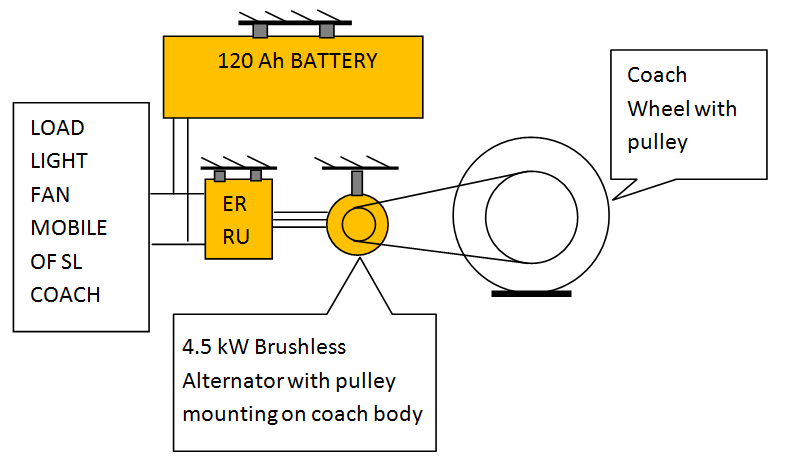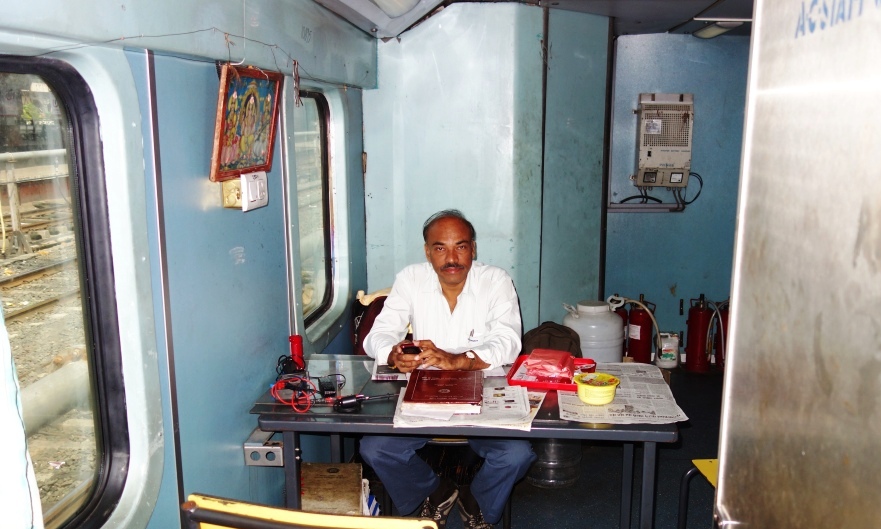Head-on-Generation for powering the running coach
How to power a rolling vehicle for illumination, fannage and air-conditioning?
There are basically three methods namely-
Self Generation:
An alternator is provided which is coupled with the coach wheel through a pulley-belt drive mechanism. There is a brushless alternator with slotted rotor with field and three phase winding housed on the stator. Due to residual magnetic field and variable reluctance, three phase voltage is induced. This voltage is rectified and fed to the field winding till such time full voltage is generated. Rectifier and Regulating Unit (RRU) and now Electronic Rectifying and Regulating Unit (ERRU) is used to convert three phase power into regulated DC 120V output. This charges the bank of DC battery and also supplies the load. This method called self generating system, existing right from the day when coaches were first illuminated. The most important advantage of this concept is its flexibility for coupling with any train. The system is similar to the one followed in car.
End-on-Generation:
In this system, DG set is provided at each end in the coach called Power Car. There are two DG sets in each car of 750kW capacity with 100% spare capacity. Power is supplied at 750V three phase AC to all coaches through 2 nos of parallel inter-vehicle coupler. End-on Generator was developed with the start of Rajdhani type trains in 1968. It was not possible to power air conditioned load of the coach through self generation at that time and composition of Rajdhani coaches was limited to few coaches, thus making it feasible to develop this concept. This system is now prevailing in all the trains such as Shatabadi, Duranto, Garib Rath, AC Express etc. The color scheme and type of coach makes the interchangeability an issue between different color scheme of the trains.
Head-on-Generation:
This is the concept making round in Indian Railways since 1970’s. In this system, power is tapped from the locomotive and fed to the train through inter coach coupler. There are large many advantages with this system but still could not find enthusiasm among the designer and planners. The load of 24 coach train (mix of SL and AC) is around 250kW and that of 21 all-AC coach train is around 1000kW. For this 2x500kVA inverter to convert single phase into three phases is provided on Electric Locomotive and first such WAP5 locomotive is now working Shatabadi express between New Delhi and Kalka successfully since 2010. Similar efforts are also in progress for provisions in Diesel Locomotive since long.
World Scenerio:
There is hardly any railway using SG system anymore. The prevailing system all over the world is either EOG or HOG. The concept of Train-sets is prevailing for medium and high speed train operation in which power supply for coaches is an integral part of the power supply system wherein power for traction as well as coach is drawn from Over head power supply system. Electrical Multiple Unit (EMU) type train works on the same concept in which the lighting and fan load is supplied from traction supply. The Metro coach air conditioning is also on this concept. The transformer capacity is to be enhanced along with provision of inverter to feed the AC load making the concept of MEMU to work as inter-city trains. This is in line with the concept of Head on generation. It is unfortunate that there is so much of drive to import of train-set from Japan or elsewhere, but no enthusiasm or commitment for developing MEMU-Intercity trains. For HOG, IR is mainly looking for its application on existing fleet of locomotive and interconnected rakes where EOG is functional.
Comparative performance of EOG/HOG/SG
SG system existed from the time of illumiantion of first lamp on the coach and EOG made its begining when full AC Rajdhani type trains were introudced.
EOG Vs HOG
- Energy Saving: NR provided HOG on locomotive number 30277WAP7 to work 2005/2006 Kalka Shatabdi and as per RDSO study, an annual saving of Rs. 55lakhs/year is estimated for this train alone.
- Saving of one power car: There are two power cars of which one can be dispensed when HOG power is available on the system. Saving one power car means generating capacity for passenger travel.
- Noise: IR has not been able to address the problem of noise emanating from power car and is the biggest irritant to passenger at station and even those living in nearby colonies during night time. Residential colonies have not raised any objective so far.
- Beside inter-coach power coupler, communication coupler is also provided which helps in enhancing passenger amenities with TV/Video/Internet/announcement from central location.
- The train integrity has to be maintained and when any coach is marked sick, it can only be replaced with identical coach.
HOG Vs SG
- Generating power by each coach is certainly energy inefficient. The energy efficiency of alternator, pulley-belt mechanism, Regulating unit and battery comes into play making the efficiency of power generation very low, around 35% as compared to HOG system.
- The maintenance cost is also high as it involves large number equipment such as alternator, belt drive, pulley, regulating unit and battery with double the numbers of higher capacity for AC coach and also two number of 25kVA inverter. Somehow actual assessment of the capital, operating and maintenance cost of the system has never been worked out and compared with HOG or even EOG. Such comparison would have helped the planner to expedite development of HOG or at least more and more EOG.
Expected future developments
This is the area which offers innovation and development opportunity with the help of industry and research organisations. RDSO is looking for
- Finalisation of HOG scheme and large scale implementation
- Development of end power coach with mounting of under slung one DG set of 500/250 kW and two Inverter set of 500/250kVA capacity for full AC train and others with part AC coaches respectively.
You may also like:
- Where has 150 millions Indian Railway passenger gone?
- Are Special or Premium Trains earning satisfactorily in Indian Railways?
- Indian Railways begins E-catering on trial – a small step…
- Cooking by Induction Heating for Indian Railways
- Climbing stairs at Railway Station is nightmare for many
- Why not confirmed seat on demand before 2020?

Excellent articles. Am a railway buff. Happened by chance to get on with this site
Informative and we’ll researched.
Thanks
Superb Article. But only problem can occur is, the performance of locomotive specifically Diesel locos. – Rajanish Joshi
Excellent article. Never knew all these. Thanks
Nice explaination